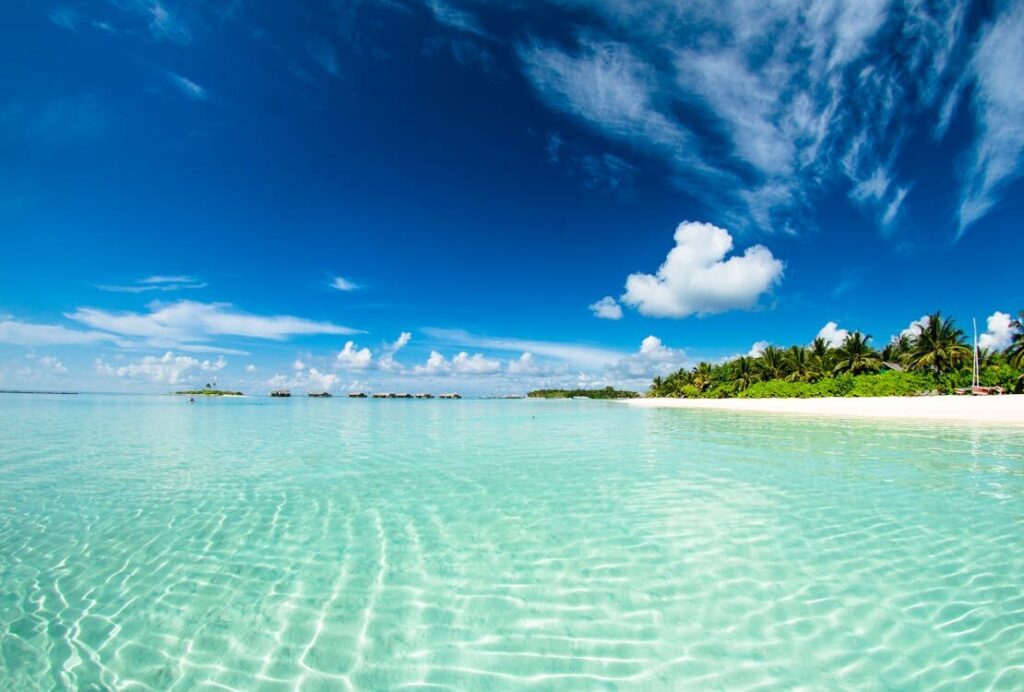The Maldives archipelago (about 1,200 coral islands in 26 atolls) is globally renowned for its marine biodiversity, and sea turtles are among its most loyal underwater inhabitants.
While many booking sites mention “snorkel with turtles” in passing, deeper planning is essential. In this guide I’ll help you understand when, where, how much, what to bring, and safety & conservation tips so your trip is well informed and respectful of marine life.

Which Turtle Species You’re Likely to See
In Maldivian waters, the two most common sea turtle species encountered by snorkelers are:
- Green sea turtles: often found grazing on seagrass beds or resting near reefs
- Hawksbill turtles: more reef-associated, often seen near coral walls or among coral crevices
Less frequently, you might glimpse an Olive Ridley or even a Loggerhead in deeper waters, but those are rare in snorkeling zones.
Best Atolls & Snorkel Sites for Turtle Encounters
Some atolls and sites are more reliable for turtle sightings than others. Here’s a comparison to help narrow your choices:
| Atoll / Area | Advantages for turtle encounters | Considerations / trade-offs |
|---|---|---|
| Ari Atoll (North & South Ari) | Many resorts in Ari include turtle sighting tours, house reefs with drop-offs, and proximity to Whale Shark Point (bonus). | Some snorkeling is off-reef; you may need boat excursions. |
| Baa Atoll (near Hanifaru Bay region) | Rich marine environment, good reef systems, and fewer crowds in off-peak seasons. | Hanifaru itself is heavily regulated (mainly for manta/whale shark), so turtle snorkeling is more often in peripheral reefs. |
| North & South Malé Atolls | Closest to the capital and airport; fast boat transfers; many resort house reefs like Baros, Vabbinfaru, Helengeli | Some reefs suffer from coral bleaching or lower reef health near inhabited islands. |
| Lhaviyani Atoll | Often described as “pristine,” with good reef drop-offs and frequent turtle & shark sightings. | More remote — you’ll face longer transfer times or seaplane rides. |
Tip: If your priority is turtle snorkeling, select resorts or liveaboard routes whose house reefs are known for turtle presence, and check recent guest reviews or reef health reports before booking.
When to Go – Seasonality & Conditions
Best Season for Visibility & Calm Seas
- Dry season (Northeast Monsoon, December to April): calm seas, better underwater visibility, lower rainfall — optimal for snorkeling.
- Shoulder months (May, November): visibility is still decent, fewer tourists, slight risk of rain or wind.
- Wet season (June to October, Southwest Monsoon): higher rainfall, rougher seas, more turbidity — still possible to snorkel, but conditions are less reliable.
Turtle presence is year-round; the variable is water clarity and ease of snorkeling.
Daily Timing
- Early morning (shortly after sunrise) often offers the calmest water and best light for visibility.
- Around high tide, some reef flats may become swimmable where they’re too shallow at low tide.
- Avoid snorkeling at dusk or night without guides, unless part of a managed reef or conservation program.
Getting There & Logistics
Arrival: Malé International Airport (MLE)
All international flights land at Velana International Airport (near Malé). From there, you must travel onward to your resort or liveaboard.
Transfers to Resorts & Atolls
Depending on the resort’s location, transfers can involve:
- Speedboat transfer: for resorts near Malé (20 minutes to 1 hour)
- Domestic seaplane flight (often + boat): for mid- or outer atolls; roundtrip seaplane transfers can cost USD 500–700 (sometimes less if shared)
- Domestic flight + boat / speedboat: sometimes a mix of small internal flight and then boat (especially for distant atolls)
- Liveaboard: you board a cruising vessel from a central hub and move between reefs, removing the need for transfers each day
Be aware of luggage weight limits on seaplanes and domestic flights (often strict, e.g. ≤ 20 kg). Many resorts require you to book the transfer via them to coordinate arrivals.
Comparison: Resort-Based vs Liveaboard vs Local-Island Base
| Mode | Pros | Cons / Risks |
|---|---|---|
| Resort-based snorkeling & excursions | Greatest convenience; gear and supervision provided; ideal for families and mixed-activity holidays | May limit you to a few nearby reefs; reefs may be overused; timing constraints |
| Liveaboard cruises (snorkeling-only or mixed) | Access to remote reefs, variety, extended snorkeling time | More expensive; seasickness risk; less flexibility on land time |
| Staying on inhabited local islands, hiring local dives/snorkelers | Lower lodging costs; cultural immersion; competitive pricing | Limited reef access from shore; may require more travel to prime reefs; variable operator quality |
If your main focus is turtle snorkeling, a hybrid strategy often works best: spend part of your trip in a coral-rich resort or aboard a boat, and part on a local island to save costs.